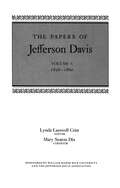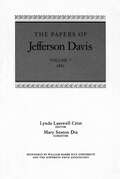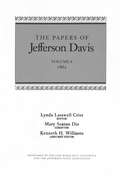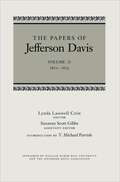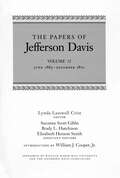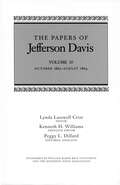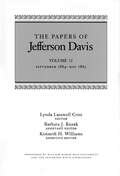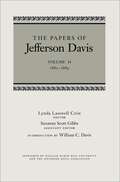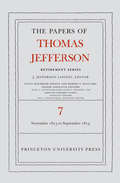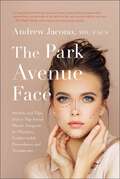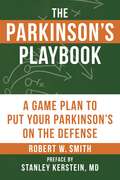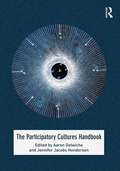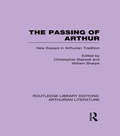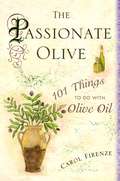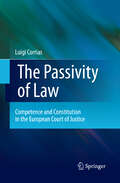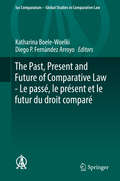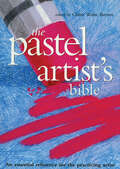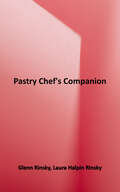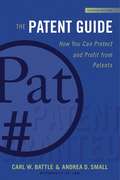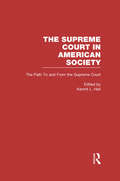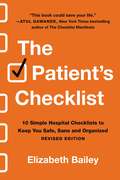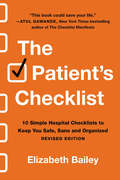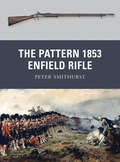- Table View
- List View
The Papers of Jefferson Davis: 1861 (The Papers of Jefferson Davis #7)
by Jefferson DavisLynda Lasswell Crist, EditorMary Seaton Dix, CoeditorIntroduction by Frank E. VandiverVolume 7 of The Papers of Jefferson Davis offers a unique view of 1861, the first year of the Confederacy, Davis' presidency, and the Civil War.On January 21 Davis made his affecting farewell speech before a hushed Senate, then left for Mississippi. His uncertainty over a military or political course vanished when he received news of his unanimous election as president of the Confederate States of America. Inaugurated at Montgomery, Alabama, on February 18, Davis quickly set to work to forge a government, in a race with events to select a cabinet, establish departments, and plan for the common defense.Hopes for a peaceful separation from the North ended with the firing on Fort Sumter; subsequent documents reveal a president absorbed by the problems of waging a war that soon stretched from the Atlantic Coast to the Gulf of Mexico. Victory at Manassas produced euphoria among southerners but plunged the president into the first of several unfortunate controversies with his generals, this one over the failure to pursue the enemy and capitalize on success.Throughout 1861 the Confederate commissioners in Europe reported to Davis on their expectations of recognition, convinced that the demand for cotton would induce Great Britain and France to break the North's blockade of southern ports and help supply arms for the defense of the fledgling nation.Volume 7 provides a rare opportunity to assess anew Davis' strengths and weaknesses as executive, to reexamine his relationship with generals, governors, congressmen, cabinet officers, the press, and the public. Davis ended the year as he begun, aware of the difficulties of the course the South had adopted and confident that its cause would ultimately triumph. Containing illustrations, maps, and more than 2,500 documents drawn from numerous printed sources and more than seventy repositories and private collections, Volume 7 covers a year of paramount importance in our country's history.
The Papers of Jefferson Davis: 1871-1879 (The Papers of Jefferson Davis #13)
by Jefferson DavisVolume 13 of The Papers of Jefferson Davis follows the former president of the Confederacy as he becomes head of the Carolina Life Insurance Company of Memphis and attempts to gain a financial foothold for his newly reunited family. Having lost everything in the Civil War and spent two years immediately afterwards in federal prison, Davis faced a mounting array of financial woes, health problems, and family illnesses and tragedies in the 1870s. Despite setbacks during this decade, Davis also began a quest to rehabilitate his image and protect his historical legacy. Although his position with the insurance company provided temporary financial stability, Davis resigned after the Panic of 1873 forced the sale of the company and its new owners canceled payments to Carolina policyholders. He left for England the following year in search of employment and to recuperate from ongoing illnesses. In 1876, Davis became president of the London-based Mississippi Valley Society and relocated to New Orleans to run the company. Throughout the 1870s, Davis waged an expensive and seemingly endless legal battle to regain his prewar Mississippi plantation, Brierfield. He also began working on his memoirs at Beauvoir, the Gulf Coast estate of a family friend. Though disfranchised, Davis addressed the subject of politics with more frequency during this decade, criticizing the Reconstruction policies of the federal government while defending the South and the former Confederacy. The volume ends with Davis's inheritance of Beauvoir, which was his last home. The editors have drawn from over one hundred manuscript repositories and private collections in addition to numerous published sources in compiling Volume 13.
The Papers of Jefferson Davis: January–September 1863 (The Papers of Jefferson Davis #9)
by Jefferson Davis?
The Papers of Jefferson Davis: July 1846–December 1848 (The Papers of Jefferson Davis #3)
by Jefferson DavisLynda L. Crist, Associate EditorMary S. Dix, Assistant EditorAt the end of Volume 2 Jefferson Davis had left Congress to become a colonel in the First Mississippi Regiment. The first item in this volume is a speech as he prepares to leave on a riverboat to serve in the Mexican War. The years 1846 through 1848 see Davis play a conspicuous role in the war and in the subsequent political clashes and controversies over slavery.Volume 3 details Davis' first experience in battle as an officer of a regiment as well as his initial term as a U.S. senator. He received both praise and criticism for his leadership in Mexico. In 1847 he returned to Mississippi a wounded hero of national fame, refused a brigadier generalship, and took his place in the U.S. Senate.There are several items of correspondence with Zachary Taylor that shed light on Taylor's attitude toward the proposed nomination that would lead to his election as president in 1848. Davis' first wife was Taylor's daughter; and in spite of political and family differences the two men maintained a close friendship. In a major speech in July, 1848, Davis protested the formal prohibition of slavery from the Oregon Territory; he then voted for the Senate's compromise bill on Oregon.Volume 3 of The Papers of Jefferson Davis includes letters to and from Davis, his speeches in chronological order, and other documents, further illuminating Davis' character, opinions, philosophy, and personal relationships as well as continuing the development of his military career.
The Papers of Jefferson Davis: June 1865–December 1870 (The Papers of Jefferson Davis #12)
by Jefferson Davis"Being powerless to direct the current, I can only wait to see whither it runs," wrote Jefferson Davis to his wife, Varina, on October 11, 1865, five months after the victorious United States Army took him prisoner. Indeed, in the tumultuous years immediately after the Civil War, Davis found himself more acted upon than active, a dramatic change from his previous twenty years of public service to the United States as a major political figure and then to the Confederacy as its president and commander in chief. Volume 12 of The Papers of Jefferson Davis follows the former president of the Confederacy as he and his family fight to find their place in the world after the Civil War. A federal prisoner, incarcerated in a "living tomb" at Fort Monroe while the government decided whether, where, and by whom he should be tried for treason, Davis was initially allowed to correspond only with his wife and counsel. Released from prison after two hard years, he was not free from legal proceedings until 1869. Stateless, homeless, and without means to support himself and his young family, Davis lived in Canada and then Europe, searching for a new career in a congenial atmosphere. Finally, in November 1869, he settled in Memphis as president of a life insurance company and, for the first time in four years, had the means to build a new life.Throughout this difficult period, Varina Howell Davis demonstrated strength and courage, especially when her husband was in prison. She fought tirelessly for his release and to ensure their children's education and safety. Their letters clearly demonstrate the Davises' love and their dependence on each other. They both worried over the fate of the South and of family members and friends who had suffered during the war. Though disfranchised, Davis remained careful but not totally silent on the subject of politics. Even while in prison, he wrote without regret of his decision to follow Mississippi out of the Union and of his unswerving belief in the constitutionality of state rights and secession. Likewise, he praised all who supported the Confederacy with their blood and who, like himself, had lost everything.
The Papers of Jefferson Davis: October 1863–August 1864 (The Papers of Jefferson Davis #10)
by Jefferson DavisKenneth H. Williams, Associate Editor Peggy L. Dillard, Editorial Associate The autumn of 1863 was a trying time for Jefferson Davis. Even as he expressed unwavering confidence about the eventual success of the Confederate movement, he had to realize that mounting economic problems, low morale, and rotating army leadership were threatening the welfare of the new nation. Less than a year after the October 1863 Confederate victory at Chickamauga, the South relinquished Atlanta to Sherman. During the tumultuous eleven months chronicled in Volume 10, Davis retained his fervor for southern nationalism as he struggled furiously to command a war and maintain a government. As the letters contained here illustrate, he soldiered bravely on.
The Papers of Jefferson Davis: September 1864–May 1865 (The Papers of Jefferson Davis #11)
by Jefferson DavisDuring the last nine months of the Civil War, virtually all of the news reports and President Jefferson Davis's correspondence confirmed the imminent demise of the Confederate States, the nation Davis had striven to uphold since 1861. But despite defeat after defeat on the battlefield, a recalcitrant Congress, naysayers in the press, disastrous financial conditions, failures in foreign policy and peace efforts, and plummeting national morale, Davis remained in office and tried to maintain the government -- even after the fall of Richmond -- until his capture by Union forces on May 10, 1865. The eleventh volume of The Papers of Jefferson Davis follows the last tumultuous months of the Confederacy and illuminates Davis's policies, feelings, ideas, and relationships, as well as the viewpoints of hundreds of southerners -- critics and supporters -- who asked for favors, pointed out abuses, and offered advice on myriad topics. Printed here for the first time are many speeches and a number of new letters and telegrams. In the course of the volume, Robert E. Lee officially becomes general in chief, Joseph E. Johnston is given a final command, legislation is enacted to place slaves in the army as soldiers, and peace negotiations are opened at the highest levels. The closing pages chronicle Davis's dramatic flight from Richmond, including emotional correspondence with his wife as the two endeavor to find each other en route and make plans for the future in the wreckage of their lives.The holdings of seventy different manuscript repositories and private collections in addition to numerous published sources contribute to Volume 11, the fifth in the Civil War period.
The Papers of Jefferson Davis: September 1864–May 1865 (The Papers of Jefferson Davis #14)
by Jefferson Davis Lynda Lasswell Crist Mary Seaton Dix Kenneth H. WilliamsThe final volume of The Papers of Jefferson Davis follows the former president of the Confederacy through the completion of his two monumental works on the history of the Confederate States of America. In the first, The Rise and Fall of the Confederate Government (1881), Davis sought to recast the Confederacy as a just and moral nation that was constitutionally correct in standing up for its rights. Himself the subject of heated debates about why the Confederacy lost, Davis also used the book to castigate Confederate government and military officials who he believed had failed the cause. Later, A Short History of the Confederate States (1890) attempted to burnish the image of the former Confederacy and to refute accusations of intentional mistreatment of Union prisoners. While completing these books, Davis attended and spoke at numerous Confederate memorial services and monument dedications, all the while waging a bitter feud with two of his former top generals-Joseph E. Johnston and P. G. T. Beauregard-over the reasons for the fall of the Confederacy. In late 1889, having returned to New Orleans from a trip to his plantation, Brierfield, Davis succumbed to pneumonia. His funeral procession attracted an estimated 150,000 mourners, a testament to the lasting popularity of the Confederacy's only president. In volume 14 of The Papers of Jefferson Davis, the editors have drawn from over one hundred manuscript repositories and private collections, in addition to numerous published sources, to offer a compelling portrait of Davis over the last decade of his life.
The Papers of Thomas Jefferson, Retirement Series: 28 November 1813 to 30 September 1814
by Thomas Jefferson J. Jefferson LooneyThe 526 documents printed in this volume run from 28 November 1813 to 30 September 1814. During this period Jefferson reviews the extant sources on the 1765 Stamp Act crisis to aid William Wirt, a Patrick Henry scholar; records his largely positive impressions of George Washington; and updates a reading list for law students that he had initially drawn up forty years earlier. In the spring of 1814 Jefferson becomes a trustee of the Albemarle Academy, the earliest direct ancestor of the University of Virginia. He is soon actively involved in planning for its establishment, helping to draft rules for governance of the academy's trustees and propose funding options, and he lays out an expansive vision for its future as an institution of higher learning. Jefferson also exchanges ideas on collegiate education with such respected scholars as Thomas Cooper and José Corrêa da Serra. Jefferson's wide-ranging correspondence includes a temperate response to a lengthy letter from Miles King urging the retired president to reflect on his personal religion, and a diplomatic but noncommittal reply to a proposal by Edward Coles that the author of the Declaration of Independence employ his prestige to help abolish slavery. Having learned of the British destruction late in August 1814 of the public buildings in Washington, Jefferson offers his massive book collection as a replacement for the Library of Congress. The nucleus for one of the world's great public libraries is formed early in 1815 when the nation purchases Jefferson's 6,707 volumes.
The Park Avenue Face: Secrets and Tips from a Top Facial Plastic Surgeon for Flawless, Undetectable Procedures and Treatments
by Andrew JaconoYour face defines you. It influences how people perceive you at work, at play, and even at home. But what if something about your face doesn't make you feel like the real you? In The Park Avenue Face, dual board-certified facial plastic and reconstructive surgeon Dr. Andrew Jacono reveals how to achieve flawless, undetectable plastic surgery so you can fix what you don't like, restore what you've lost, or prevent signs of aging. From his elite Park Avenue aesthetic surgery center, Dr. Jacono has enhanced tens of thousands of faces not by prescribing an arbitrary standard of beauty, but by amplifying each patient's individual beauty for totally natural results. A global authority in advanced facial plastic surgery, he has presented clinical research and conducted live surgery in front of peer audiences at over 100 plastic surgery symposiums around the world, including at Harvard, Yale and Stanford Universities. Now, he's ready to share his expertise with you. High-end Park Avenue clients want to fight the signs of aging while highlighting their best features. They want lips that look like their own lips, eyes that look like their own eyes. They want facial features in line with their ethnicities. Park Avenue clients want to look powerful yet approachable, wise yet fresh, and above all, natural. With Dr. Andrew Jacono's advice, you can have the Park Avenue Face no matter who you are or where you live. The Park Avenue Face also highlights a trend unique to the United States—a distinct difference between conceptions of beauty on the west coast versus the east coast. Where the West Coast Style is often about changing your personal signature, the East Coast Style prioritizes maintaining your personal signature. Through this up-close look at coastal trends, the reader will learn how to define and achieve a natural look—a face that reflects the person they have always been, and the person they strive to be, not someone they don't recognize in the mirror. If you want a face with character and depth that looks ageless and don't want a stretched, artificial or generic look, Dr. Jacono will show you how to get there. If you are considering any kind of facial enhancement, from minor and non-invasive treatments such as simple injections or a laser treatment to more involved surgical procedures such as a full-on facelift, this is your resource. The Park Avenue Face will show you how to avoid the quacks, the fads, the financial waste, and the dangers. Dr. Jacono will help you determine how you want to look and how best to get there. Featuring fascinating patient anecdotes, dozens of before-and-after photographs showing what the various procedures can accomplish and line drawings by veteran medical illustrator William Winn, this comprehensive guide will fully prepare you to step into a doctor's office and discuss your facial enhancement options. You'll know how each treatment works, how long you will take to recover, and how much change you can expect. If there is something about your face you think is holding you back—decide if making a change is right for you. Let The Park Avenue Face guide you to becoming your best you.
The Parkinson's Playbook: A Game Plan to Put Your Parkinson's On the Defense
by Robert Smith Stanley KersteinThe Parkinson’s Playbook puts the power in your hands, giving you the knowledge you need to proactively defend yourself against the progression of Parkinson’s disease with energy, vitality, and confidence.The diagnosis of Parkinson’s disease is not an easy one. In The Parkinson’s Playbook, author Robert Smith has prepared an enlightening and engaging “playbook” to help you tackle Parkinson’s head on, including a pro-active offense of lifestyle improvements and defensive measures including cutting-edge medications and natural healing techniques.The Parkinson’s Playbook makes you the MVP of your life—so get out there and win!Also featured in The Parkinson’s Playbook:• How to assemble a line-up of medical and emotional support systems• Learn the importance of exercise to boost strength and relieve stress• Effective, easy-to-implement diet changes for well-being...and so much more, all with the unique patient’s perspective of the author’s personal experiences fighting—and winning—against his disease.
The Participatory Cultures Handbook
by Aaron Delwiche Jennifer Jacobs HendersonHow did we get from Hollywood to YouTube? What makes Wikipedia so different from a traditional encyclopedia? Has blogging dismantled journalism as we know it? Our media landscape has undergone a seismic shift as digital technology has fostered the rise of "participatory culture," in which knowledge is originated, created, distributed, and evaluated in radically new ways. The Participatory Cultures Handbook is an indispensable, interdisciplinary guide to this rapidly changing terrain. With short, accessible essays from leading geographers, political scientists, communication theorists, game designers, activists, policy makers, physicists, and poets, this volume will introduce students to the concept of participatory culture, explain how researchers approach participatory culture studies, and provide original examples of participatory culture in action. Topics include crowdsourcing, crisis mapping, grid computing, digital activism in authoritarian countries, collaborative poetry, collective intelligence, participatory budgeting, and the relationship between video games and civic engagement. Contributors include: Daren Brabham, Helen Burgess, Clay Calvert, Mia Consalvo, Kelly Czarnecki, David M. Faris, Dieter Fuchs, Owen Gallagher, Clive Goodinson, Alexander Halvais, Cynthia Hawkins, John Heaven, The Jannissary Collective, Henry Jenkins, Barry Joseph, Christopher Kelty, Pierre Lévy, Sophia B. Liu, Rolf Luehrs, Patrick Meier, Jason Mittell, Sarah Pearce, W. James Potter, Howard Rheingold, Suzanne Scott, Benjamin Stokes, Thomas Swiss, Paul Taylor, Will Venters, Jen Ziemke
The Passing of Arthur: New Essays in Arthurian Tradition (Routledge Library Editions: Arthurian Literature)
by Christopher Baswell William SharpeOriginally published in 1988, this volume contains papers from, and commissioned after, "The Passing of Arthur", a conference on Medieval and Renaissance Studies in November 1986. No Arthurian story is experienced without some foreknowledge of its end, which the text acknowledges through a complex range of methods. This collection takes this as its point of origin, suggesting that all such narratives concern the passing of Arthur, even indirectly, so the chapters not only look at the death of Arthur but the passing on and development of the Arthurian literature. The figure of Arthur and the Round Table continues to fascinate contemporary readers. This interesting collection presents a wide range of Arthurian studies approaches representing some of the vast scholarship on the genre.
The Passionate Olive: 101 Things to Do with Olive Oil
by Carol FirenzeFor more than four thousand years, the olive tree has been a symbol of abundance, peace, and longevity. Gifted by a goddess, revered by ancient cultures, and protected by emperors, the olive tree and its precious fruit have played important roles in civilization.Dubbed "liquid gold" by Homer, olive oil has been used for food, medicine, magic, beauty, and divine rituals. Baseball star Joe DiMaggio is even said to have soaked his bat in olive oil. And while it is no longer drawn upon to treat leprosy or massage elephants, the use of this versatile product is growing by leaps and bounds around the world.The Passionate Olive is the ultimate guide to this natural marvel. Along with olive legends and fascinating history, Carol Firenze shares the myriad practical uses of olive oil through the telling of her favorite family stories and by offering unique formulas and recipes.Restore luster to your pearls . . . curb your cat's hair-ball problems . . . silence squeaky doors hinges . . . soothe your sore throat and dry lips . . . replace artery-clogging butter in your favorite dishes with . . . can you guess? The Passionate Olive reveals the secrets of how to enhance your life, love, and health with olive oil and merits a front-and-center spot among your most cherished books. It makes a beautiful gift, too, for just about everyone and every occasion. In fact, you and your friends will want to keep The Passionate Olive and a bottle of olive oil in your kitchen, your bathroom, and even your bedroom.From the Hardcover edition.
The Passivity of Law
by Luigi CorriasAt the heart of this book, a question: what to make of the creeping competences of the EU and of the role the European Court of Justice plays in this respect? Taking the implied powers doctrine as its starting point, the hypothesis is that it shows what is ultimately at stake in the concept of legal competence: the problem of creation in law, or the relationship between constituent and constituted power. By rethinking this relationship, a new conceptual framework to make sense of creeping competences is designed. For this, the work of Maurice Merleau-Ponty is used. Tracing back the philosophical roots of creation, legal constitution is understood as constitution in passivity. This leads to a whole new interpretation of the relationship between law and politics, rule following, authority, competences and European integration. From this perspective specific chapters in the case law of the European Court of Justice are reread and the logic behind the competence creep is unmasked. new back cover copy: Europe's constitutional journey has not been a smooth one, and a better division and definition of competence in the European Union is a key issue that needs to be addressed. How can the division of competence be made more transparent? Does there need to be a reorganization of competence? How can it be ensured that the redefined division of competence will not lead to a creeping expansion of the competence of the Union or to encroachment upon the exclusive areas of competence of the Member States and, where there is provision, regions? And how can it be ensured that the European dynamic does not come to a halt? Indeed, has the creeping expansion of the competence of the Union already come to a halt? These are the questions this book explores. The Passivity of Law: Competence and Constitution in the European Court of Justice opens with a legal account of competence creep, including the role that the European Court of Justice plays in it and a sketch of the present division of competences and the main principles regulating it. It then discusses the relationship between constituent power and constituted or constitutional power from the viewpoint of the history of constitutional history before offering an alternative theory of their relationship, known as "chiastic theory," which is based on the philosophical investigations of Merleau-Ponty. It details how chiastic theory can be used to make sense of the Court's role in the competence creep in general and the doctrine of implied powers in particular, and it utilizes several case studies concerning competences to sustain this claim. Aimed at researchers and practitioners in Philosophy, Phenomenology, Political Science, the Social Sciences and numerous fields of law, this monograph is a seminal work in the evolving theory and practice of EU law.
The Past, Present and Future of Comparative Law - Le passé, le présent et le futur du droit comparé: Ceremony of 15 May 2017 in Honour of 5 Great Comparatists - Cérémonie du 15 mai 2017 en l'honneur de 5 grands comparatistes (Ius Comparatum - Global Studies in Comparative Law #29)
by Katharina Boele-Woelki Diego P. Fernàndez ArroyoThis book is published by the International Academy of Comparative Law to honor five great comparatists: Jean-Louis Baudouin from Canada, Xavier Blanc-Jouvan from France, Mary Ann Glendon from the United States of America, Hein Kötz from Germany, and Rodolfo Sacco from Italy. The five great minds present their thoughts on the past, the present and future of comparative law and in doing so they particularly focus on the future of the International Academy of Comparative Law, comparative law methodology and the teaching of comparative law. The book is essential reading for researchers and academics wanting to know what these respected legal scholars have contributed to comparative law, how they differ and when and why they excelled. Moreover, the views presented suggest how the role of the Academy can be developed in order to deal with the current challenges of comparative law.Ce livre est publié par l'Académie internationale de droit comparé en l'honneur de cinq grands comparatistes : Jean-Louis Baudouin du Canada, Xavier Blanc-Jouvan de France, Mary Ann Glendon des États-Unis, Hein Kötz d'Allemagne et Rodolfo Sacco d'Italie. Ces cinq grands esprits offrent leurs réflexions sur le passé, le présent et le futur du droit comparé et, ce faisant, se concentrent particulièrement sur l'avenir de l'Académie internationale de droit comparé, la méthodologie ainsi que l'enseignement du droit comparé. Ce livre est une lecture essentielle pour les chercheurs et les universitaires qui s’intéressent aux contributions au droit comparé de ces juristes respectés, la manière dont ils diffèrent et quand et pourquoi ils ont excellé. De plus, les points de vue présentés suggèrent comment le rôle de l'Académie peut être développé pour faire face aux défis actuels du droit comparé.
The Pastel Artist's Bible: An Essential Reference for the Practicing Artist (Artist's Bibles Ser.)
by Claire Waite BrownA comprehensive guide to one of the most popular painting media—including materials, color, techniques, and subjects from still lifes to animals.Discover the unique joys of pastel painting with this easy-to-use guide to one of the most versatile and forgiving mediums. More than one hundred visual sequences reveal key techniques such as mixing, blending, scumbling, sgraffito, hatching and feathering. Includes tips on composing your painting, using color, adding highlights and shadows, and creating textured effects. Step-by-step demonstrations show how to approach a range of subjects from landscapes and flowers to portraits and still life. Over 65,000 copies sold worldwide.
The Pastry Chef's Companion: A Comprehensive Resource Guide for the Baking and Pastry Professional
by Glenn Rinsky Laura Halpin RinskyWith more than 4,800 terms and definitions from around the world plus ten appendices filled with helpful resources, The Pastry Chef's Companion combines the best features of a dictionary and an encyclopedia. In addition to the current terminology of every component of pastry, baking, and confectionary arts, this book provides important information about the origin and historical background of many of the terms. Moreover, it offers coverage of flavor trends, industry practices, key success factors, a resource list, illustrations, and phonetic pronunciations.
The Patent Guide: How You Can Protect and Profit from Patents (Second Edition) (Allworth Intellectual Property Made Easy)
by Carl W. Battle Andrea D. Small"Recommended." —Library Journal Coming up with a million-dollar idea is only the first step in what might seem like a long and difficult process. In The Patent Guide, Second Edition, experienced patent attorneys Carl W. Battle and Andrea D. Small deliver basic and comprehensive advice that is easy to understand and will allow you to protect, promote, and profit from your ideas. Chapters discuss such topics as: How to commercialize your invention Where to find sources of information and assistance What guidelines you should follow when obtaining a patent How to obtain foreign patent rights How to maintain confidentiality of your ideas When to use patent attorneys and agents How to deal with invention brokers and promotion firms How to enforce your patent against infringement Fully updated and revised, this new edition includes information on inventor notebooks and records, updates to the patent filing process in the United States and abroad, the latest USPTO forms and templates, and changes to electronic filing and submission procedures. With easy-to-use forms and step-by-step instructions, The Patent Guide is an indispensable tool to help minimize costs and maximize profits of your ideas and inventions.
The Path to and From the Supreme Court: The Supreme Court in American Society (The\supreme Court In American Society Ser. #Vol. 3)
by Kermit L. HallAvailable as a single volume or part of the 10 volume set Supreme Court in American Society
The Patient's Checklist: 10 Simple Hospital Checklists to Keep You Safe, Sane, and Organized
by Elizabeth Bailey"A godsend for concerned friends and relatives trying to rein in the chaos."-The New York Times Whether you're addressing the rising chaos of a pandemic or preparing for a scheduled surgery, having checklists prepared to guide you through a hospital visit can often mean the difference between comfort and pain, personal and distant care--and even life or death. In today's hospital system, you can face a series of perplexing obstacles to satisfactory care, from overworked healthcare providers to understaffed facilities--which are heightened in times of crisis. You need to know how to take charge of your own healthcare; Elizabeth Bailey shows you how to do just that with a series of essential, easy-to-use checklists to better manage, monitor, and participate in your own healthcare, including: Before You Go, What to Bring, Master Medication List, Discharge Plan, and more. It is more important than ever to have a protocol, including a detailed plan for hygiene and communications while hospitalized. You can trust the medical staff, but you also need to trust yourself or a loved one to be your own best advocate. Newly revised and completely up-to-date, The Patient's Checklist shows you how.
The Patient's Checklist: 10 Simple Hospital Checklists to Keep You Safe, Sane, and Organized
by Elizabeth Bailey"A godsend for concerned friends and relatives trying to rein in the chaos."-The New York Times Whether you're addressing the rising chaos of a pandemic or preparing for a scheduled surgery, having checklists prepared to guide you through a hospital visit can often mean the difference between comfort and pain, personal and distant care--and even life or death. In today's hospital system, you can face a series of perplexing obstacles to satisfactory care, from overworked healthcare providers to understaffed facilities--which are heightened in times of crisis. You need to know how to take charge of your own healthcare; Elizabeth Bailey shows you how to do just that with a series of essential, easy-to-use checklists to better manage, monitor, and participate in your own healthcare, including: Before You Go, What to Bring, Master Medication List, Discharge Plan, and more. It is more important than ever to have a protocol, including a detailed plan for hygiene and communications while hospitalized. You can trust the medical staff, but you also need to trust yourself or a loved one to be your own best advocate. Newly revised and completely up-to-date, The Patient's Checklist shows you how.
The Pattern 1853 Enfield Rifle
by Peter Dennis Peter SmithurstThroughout the Napoleonic Wars, there was a growing perception that a muzzle-loading rifle was more practical compared to the limitations of rifles then currently in use. This thinking ultimately resulted in the 1853 Enfield Pattern, a rifle which, for the first time, was issued to every soldier in the British Army instead of the few trained marksmen. Its use during the Crimean War and later the Indian Mutiny would vindicate this policy when it became clear that the infantry were now capable of outgunning artillery. In addition, this was the first British weapon manufactured using new American technology, which meant that the component parts were interchangeable, ensuring that the weapon was easy to maintain on the battlefield. There were three main types based on the P 53 - the long rifle, the short rifle and the carbine, and this volume provides a concise history of the development and use of each type. In addition, the book discusses the privately manufactured varieties which were used for sport as well as the standard accessories issued to the infantryman in the field including bayonets, combination tools, the cartridge, ammunition pouch, muzzle stopper and ramrods. The P 53 first became notorious during the Indian Mutiny when the use of pig fat to lubricate the bullets led directly to the rioting by Hindu and Muslim troops within the British Army. However, its most widespread use was during the American Civil War when over a million rifles were sold to both the North and South. The author, a leading expert in the subject who worked at the Royal Armouries for a number of years, also details the effectiveness of the weapon during each conflict, including range, rate of fire, powder charge, accuracy and what it was like to be fired on by a P 53.From the Trade Paperback edition.
